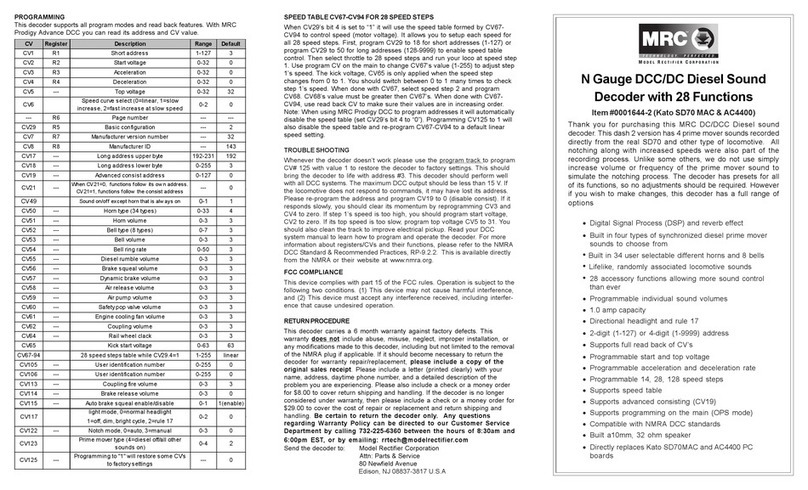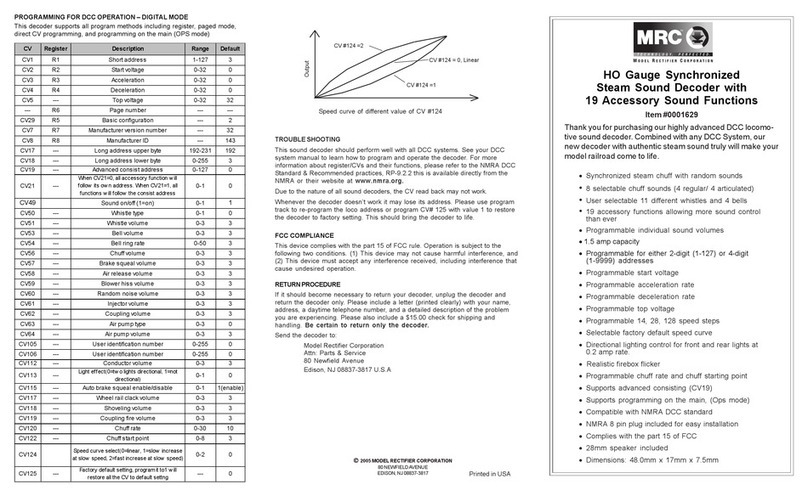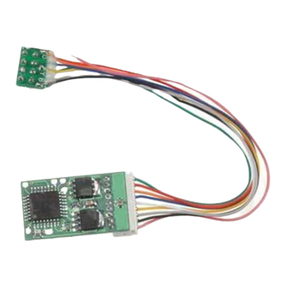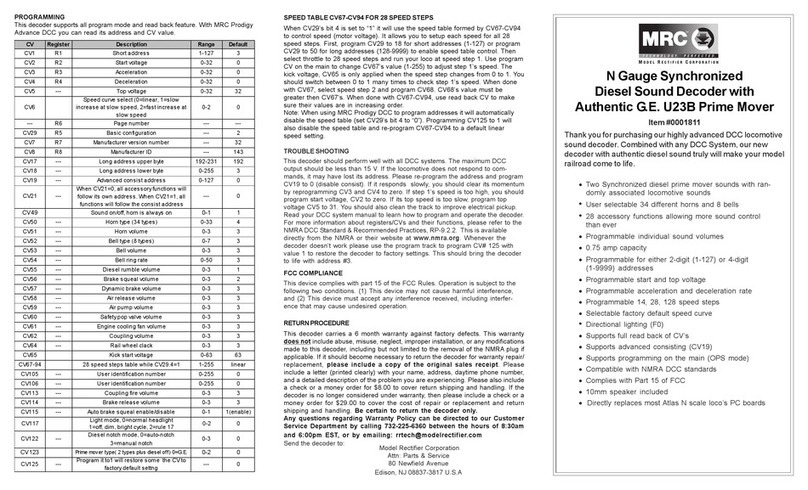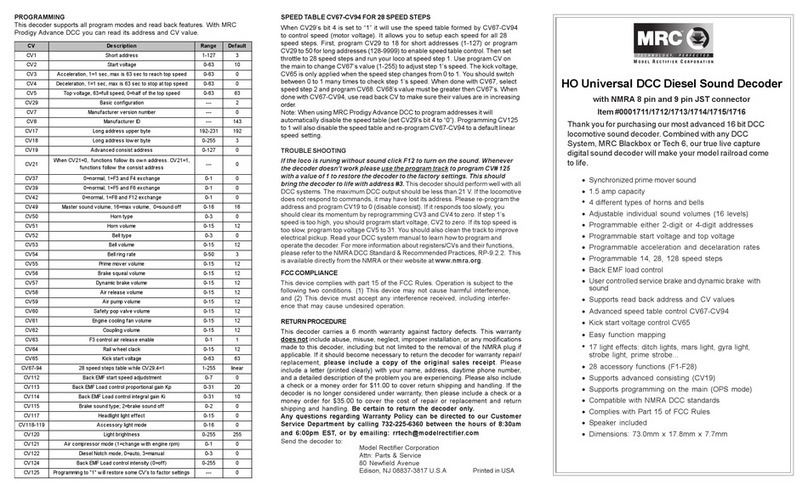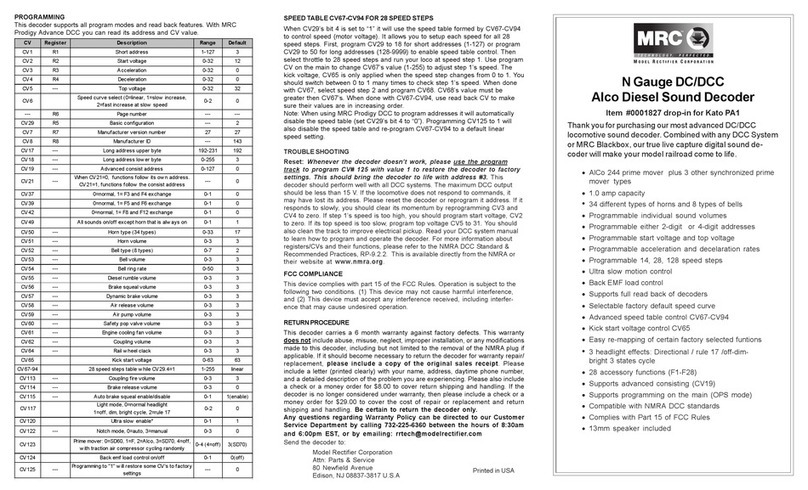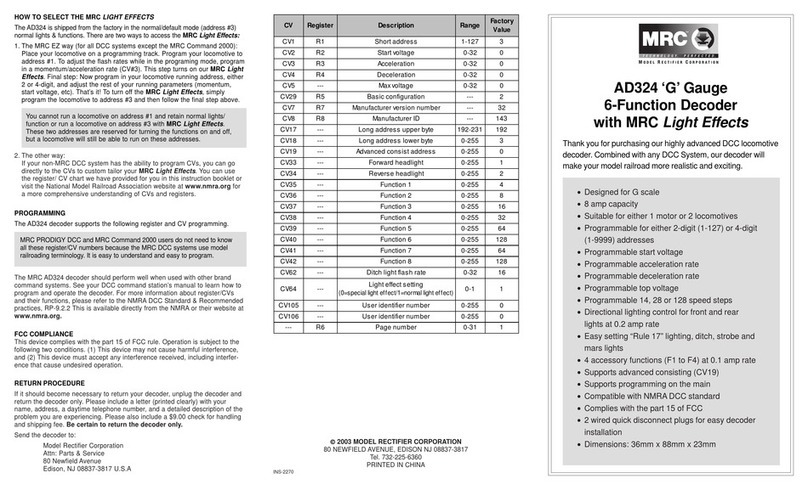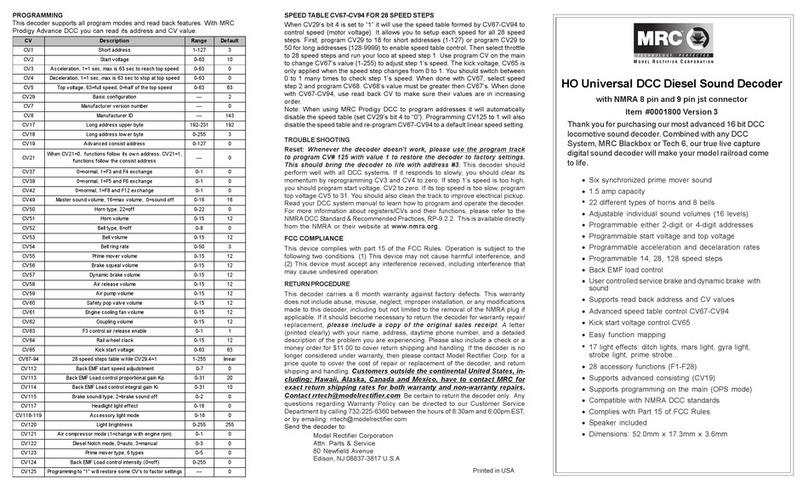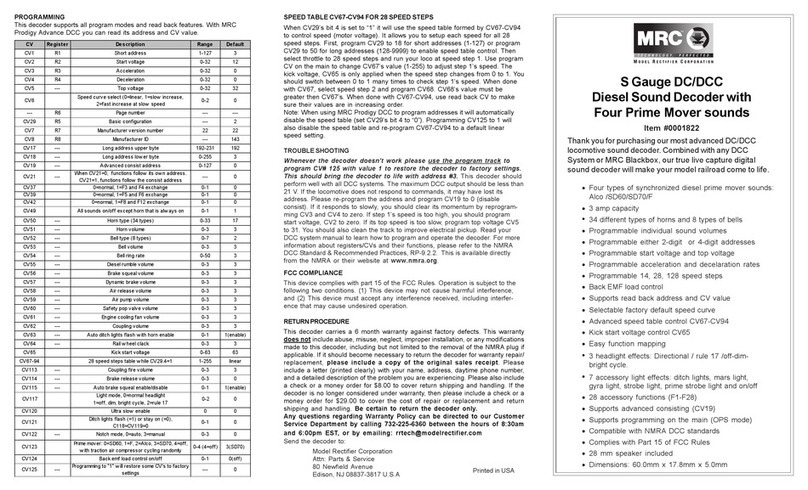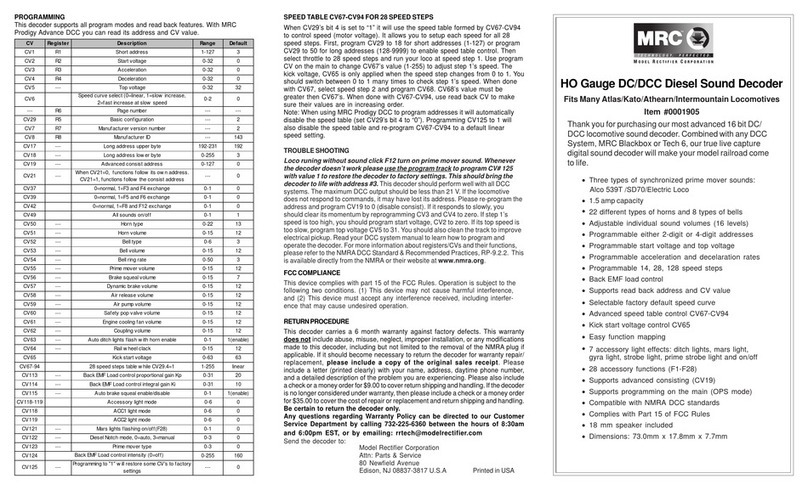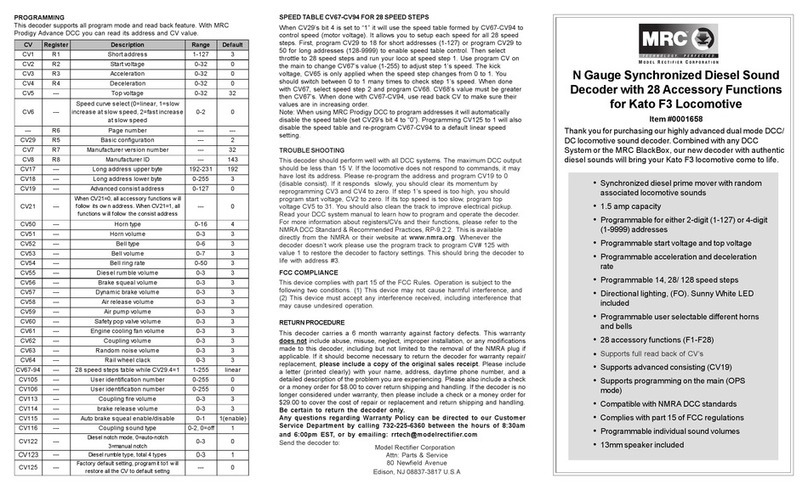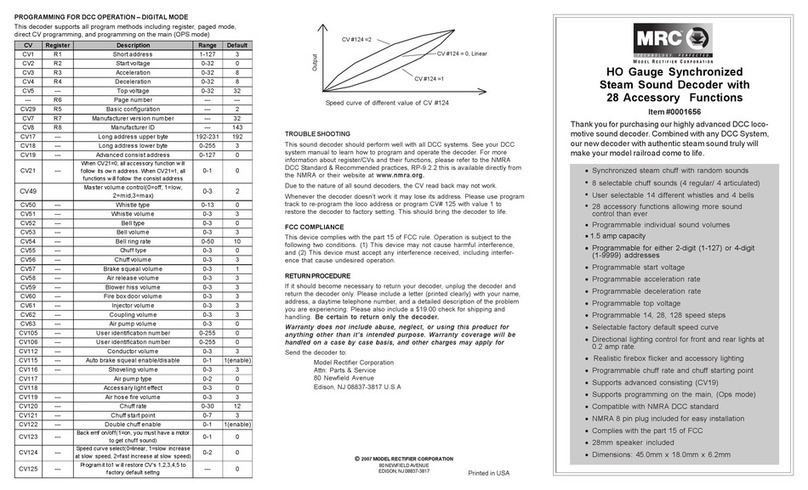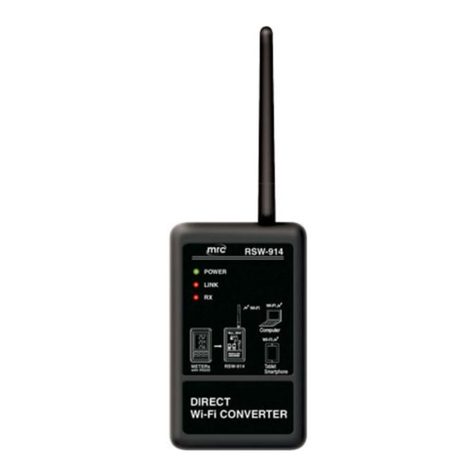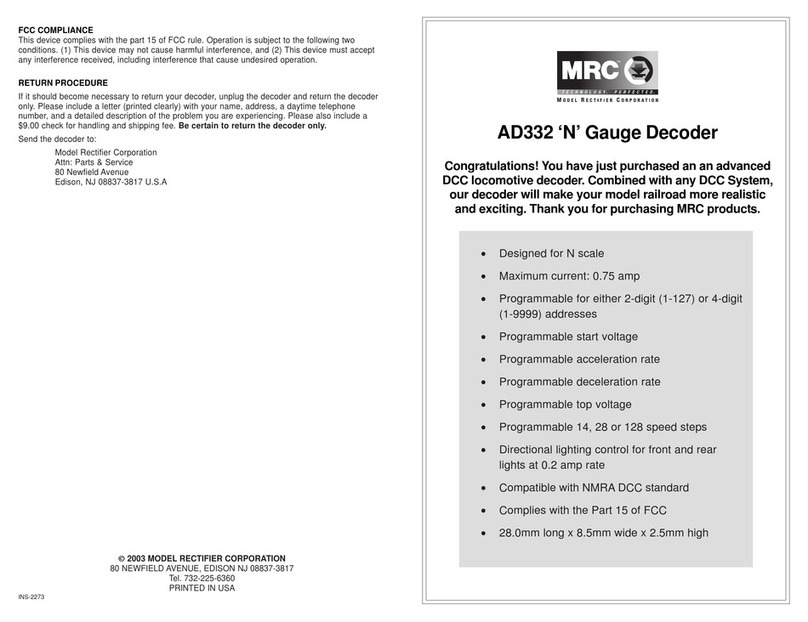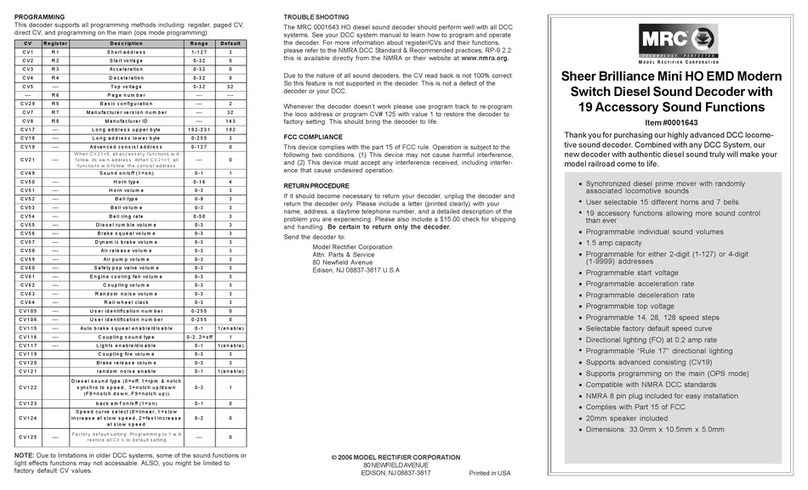
HO Gauge Synchronized
Diesel Sound Decoder with
28 Accessory Functions
Item #0001657
Thank you for purchasing our highly advanced DCC locomotive
sound decoder. Combined with any DCC System, our new
decoder with “Camegie Hall” sound quality will make your model
railroad come to life.
•Synchronized diesel prime mover with randomly associated
locomotive sounds
•1.5 amp capacity
•Programmable choice of 2 different horns and 2 bells
•Programmable individual sound volumes
•Programmable for either 2-digit (1-127) or 4-digit
(1-9999) addresses
•Programmable start voltage
•Programmable acceleration rate
•Programmable deceleration rate
•Programmable top voltage
•Programmable 14, 28, 128 speed steps
•Selectable factory default speed curve
•Directional lighting (FO) at 0.2 amp rate
•Programmable for either ditch lights, mars light, gyra
light andprime strobe light
•28 accessory functions (F1-F28)
•Supports advanced consisting (CV19)
•Supports programming on the main (OPS mode)
•Compatible with NMRA DCC standards
•NMRA 8 pin plug included for easy installation
•Complies with Part 15 of FCC
•20mm speaker with baffle included (other size, aftermar-
ket speakers are available from MRC)
•Dimensions: 46.0mm x 17.5mm x 5.0mm
•The decoder can be upgraded to all the horns included
in the Demo F19, and more choices of bells.
PROGRAMMING
This decoder supports all programming methods including: register, paged CV,
direct CV, and programming on the main (ops mode programming).
NOTE: Due to limitations in older DCC systems, some of the sound functions or
light effects functions may not accessable. ALSO, you might be limited to factory
default CV values.
2007 MODEL RECTIFIER CORPORATION
80 NEWFIELDAVENUE
EDISON, NJ 08837-3817 Printed in USA
LIGHT EFFECTS WIRING
Your MRC Synchronized Diesel Sound Decoder is equipped with normal
directional lighting, plus MRC light effects. If your loco has ditch lights, mars light
or strobe light, you can solder wires to the four solder tabs (2 pairs marked with
ACC1,ACC2) on the bottom of the decoder. The two center solder tabs are the
common for the accessory light effects.
All the decoder’s light outputs are track output voltage (around
14V) supplied by your DCC system. They are designed for 12V
light bulb. Please contact your loco manufacturer for lights’
operation voltage. If you have a 1.5V bulb use 1k ohm resistor or
LED, you should connect a 2k ohm resistor in series to one of the
leads to limit current.
TROUBLE SHOOTING
The MRC 0001657 HO diesel sound decoder should perform well with all DCC
systems. See your DCC system manual to learn how to program and operate the
decoder. For more information about register/CVs and their functions, please
refer to the NMRA DCC Standard & Recommended practices, RP-9.2.2 this is
available directly from the NMRA or their website at www.nmra.org.
Due to the nature of all sound decoders, the CV read back is not 100% correct.
This is not a defect of the decoder or your DCC. Whenever the decoder doesn’t
work please use program track to re-program the loco address or program CV#
125 with value 1 to restore the decoder to factory setting. This should bring the
decoder to life.
FCC COMPLIANCE
This device complies with the part 15 of FCC rule. Operation is subject to the
following two conditions. (1) This device may not cause harmful interference,
and (2) This device must accept any interference received, including interfer-
ence that cause undesired operation.
RETURN PROCEDURE
If it should become necessary to return your decoder, unplug the decoder and
return the decoder only. Please include a letter (printed clearly) with your name,
address, a daytime telephone number, and a detailed description of the problem
you are experiencing. Please also include a $15.00 check to cover shipping and
handling. Be certain to return only the decoder.
Warranty does not include abuse, neglect, or using this product for
anything other than it’s intended purpose. Warranty coverage will be
handled on a case by case basis, and other charges may apply for
repair/replacement of the product.
Send the decoder to:
Model Rectifier Corporation
Attn: Parts & Service
80 Newfield Avenue
Edison, NJ 08837-3817 U.S.A
CV Register Description Range Default
CV1 R1 Short address 1-127 3
CV2 R2 Start voltage 0-32 0
CV3 R3 Acceleration 0-32 0
CV4 R4 Deceleration 0-32 0
CV5 --- Top voltage 0-32 32
--- R6 Page number --- ---
CV29 R5 Basic configuration --- 2
CV7 R7 Manufacturer version number --- 32
CV8 R8 Manufacturer ID --- 143
CV17 --- Long address upper byte 192-231 192
CV18 --- Long address low er byte 0-255 3
CV19 --- Advanced consist address 0-127 0
CV49 Sound on/off (0=on) 0-1 0
CV50 --- Horn type 0-1 0
CV51 --- Horn volume 0-3 0
CV52 --- Bell type 0-1 2
CV53 --- Bell volume 0-3 3
CV54 --- Bell ring rate 0-50 3
CV55 --- Diesel rumble volume 0-3 3
CV56 --- Brake squeal volume 0-3 3
CV57 --- Dynamic brake volume 0-3 3
CV58 --- Air release volume 0-3 3
CV 59 - -- A ir pump v olume 0-3 3
CV60 --- Safety pop valve volume 0-3 3
CV61 --- Engine cooling fan volume 0-3 3
CV62 --- Coupling volume 0-3 3
CV63 --- Random noise volume 0-3 3
CV64 --- Rail w heel clack 0-3 3
CV105 --- User identification number 0-255 0
CV106 --- User identification number 0-255 0
CV112 --- Exhaust volume 0-3 3
CV113 --- Coupling fire volume 0-3 3
CV114 --- Light brightness (green, brow n) 0-12 3
CV115 --- Auto brake squeal enable/disable 0-1 1(enable)
CV116 --- Coupling sound type 0-2, 2=off 1
CV117 --- Lights enable/disable 0-1 1(enable)
CV118 --- Accessory light #1configuration 0-6 0
CV119 Accessory light #2configuration 0-6 0
CV120 Brake release volume 0-3 3
CV122
Diesel sound type (0=off, 1=rpm & notch synchro
to speed, 2=linear rpm synchro to speed, 3=notch
up/dow n (F8=notch dow n, F9=notch up))
0-3 1
CV124 Speed curve select (0=linear, 1=slow increase at
slow speed, 2=fast increase at slow speed 0-2 0
CV125 --- Factory default setting: Programming to 1 w ill
restore all CV's to default setting --- 0
CV 2 1 - - - 0
When CV21=0, all accessory functions w ill follow
its ow n address. When CV21=1, all functions w ill
follow the consist address
---












